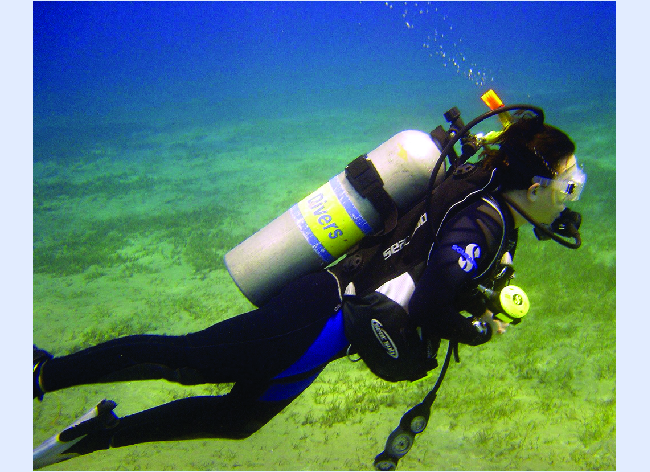In your previous studies in chemistry and physics, you will have encountered relations that connect pressure, volume, temperature, and the number of moles of the gas:
- $\frac{P}{V}$= constant at constant $T$ and $n$ (Boyle’s Law)
- $\frac{P}{T}$ = constant at constant $V$ and $n$ (Amonton’s Law)
- $\frac{V}{T}$ = constant at constant $P$ and $n$ (Charles’s Law)
- $\frac{V}{n}$ = constant at constant $P$ and $T$ (Avogadro’s Law)
Combining these four laws yields the ideal gas law, a relation between the pressure, volume, temperature, and number of moles of a gas: $$PV=nRT$$
where P is the pressure of a gas, V is its volume, n is the number of moles of the gas, T is its temperature on the kelvin scale, and R is a constant called the ideal gas constant or the universal gas constant. The units used to express pressure, volume, and temperature will determine the proper form of the gas constant as required by dimensional analysis, the most commonly encountered values being 0.08206 L atm mol–1 K–1 and 8.314 kPa L mol–1 K–1.
Gases whose properties of P, V, and T are accurately described by the ideal gas law (or the other gas laws) are said to exhibit ideal behavior or to approximate the traits of an ideal gas. An ideal gas is a hypothetical construct that may be used along with kinetic molecular theory to effectively explain the gas laws. In particular, this assumption is only reasonable for gases under conditions of relatively low pressure and high temperature. There is also a provision that can be used to predict the behaviour of non-ideal gases if needed.
The ideal gas equation contains five terms, the gas constant R and the variable properties P, V, n, and T. Specifying any four of these terms will permit use of the ideal gas law to calculate the fifth term as demonstrated in the following example exercises.
Using the Ideal Gas Law
Methane, CH4, is being considered for use as an alternative automotive fuel to replace gasoline. Four liters of gasoline could be replaced by 655 g of CH4. What is the volume of this much methane at 25.0 °C and 745 torr?
Solution
We must rearrange PV = nRT to solve for V: $$V=\frac{nRT}{P}$$
If we choose to use R = 0.08314510 L bar mol–1 K–1, then the amount must be in moles, temperature must be in kelvin, and pressure must be in bar. Conversions for gas units are here. First we convert into the “right” units for our calculation: $$n=655\;g\;CH_4\times\frac{1\;\text{mol}}{16.043\;\text{g}\;CH_4}=40.8_{278}\;\text{mol}\; CH_4$$ $$T=25.0°\text{C}+273.15=298.1_5 \;K$$ $$P=745\;\require{enclose}\enclose{horizontalstrike}{\;\text{torr}}\times\frac{1.01325\;\text{bar}}{760\;\enclose{horizontalstrike}{\;\text{torr}}}=0.993_{252}\;\text{bar}$$ Then use the ideal gas law (rearranged to solve for $V$): $$V=\frac{nRT}{P} \\ V =\frac{(40.8_{278}\;\enclose{horizontalstrike}{\text{mol} \; CH_4})(0.08314510\;\text{L}\;\enclose{horizontalstrike}{\text{bar\; mol}^{–1}\text{K}^{–1}})(298.1_5\;\enclose{horizontalstrike}{\text{K}})}{0.993_{252}\;\enclose{horizontalstrike}{\text{bar}}} \\ =101_{8.984885}\;\text{L} \\ \mathbf{=1.02\times 10^3\; \text{L}}$$
It would require about 1020 L of gaseous methane at about 1 bar of pressure to replace 4 L of gasoline. It requires a large container to hold enough methane at 1 bar to replace several liters of gasoline. (Consider – the fuel tank on an economy car is ~40 L).
Check Your Learning
Calculate the pressure in bar of 2520.0 moles of hydrogen gas stored at 27.0 °C in the 180.0 L storage tank of a modern hydrogen-powered car.
Answer
349 bar
Solving with a constant number of moles
A typical scuba tank has a volume of 12.2 L, and is filled on the surface at room temperature (25.0 ° C) to an internal pressure of 232 bar. How many liters of air will such a tank provide to a diver’s lungs (at body temperature, 37.0° C) at a depth of approximately 25 m in the ocean where the pressure is 2.45 bar?

Solution
In this situation, the amount (number of moles) of gas in the tank is constant – although our diver will be breathing it eventually, we want to know the volume the whole tank would produce. We can solve this in either of two ways:
1. Determine the number of moles of gas in the tank, then determine the volume of that amount of gas at the new T & P.
2. Solve in one step by rearranging the ideal gas law (we’ll demonstrate this method!)
First, we can isolate $n$ from the Ideal Gas Law since it is constant in this scenario: $$n = \frac{PV}{RT}$$ Now, since $n$ stays constant from the “tank conditions” (1) to “lung conditions” (2): $$n_1 = n_2 \\ \frac{P_1 V_1}{RT_1} = \frac{P_2V_2}{RT_2}$$ Then, substituting in the values we know (and cancelling $R$ since it appears on both sides of the equality!): $$\frac{232\,\text{bar}\cdot 12.2\,\text{L}}{298.15\,\text{K}} = \frac{2.45\,\text{bar}\cdot V_2}{310.15\,\text{K}} \\ V_2 = 120_{1.76265}\,\text{L}\\ V_2 = \mathbf{1.20\times 10^{3}\,\text{L}}$$
Check Your Learning
A sample of ammonia is found to occupy 0.250 L under laboratory conditions of 27.0 °C and 0.850 bar. Find the volume of this sample at 273.15 K and 1.00 bar.
Answer
0.193 L